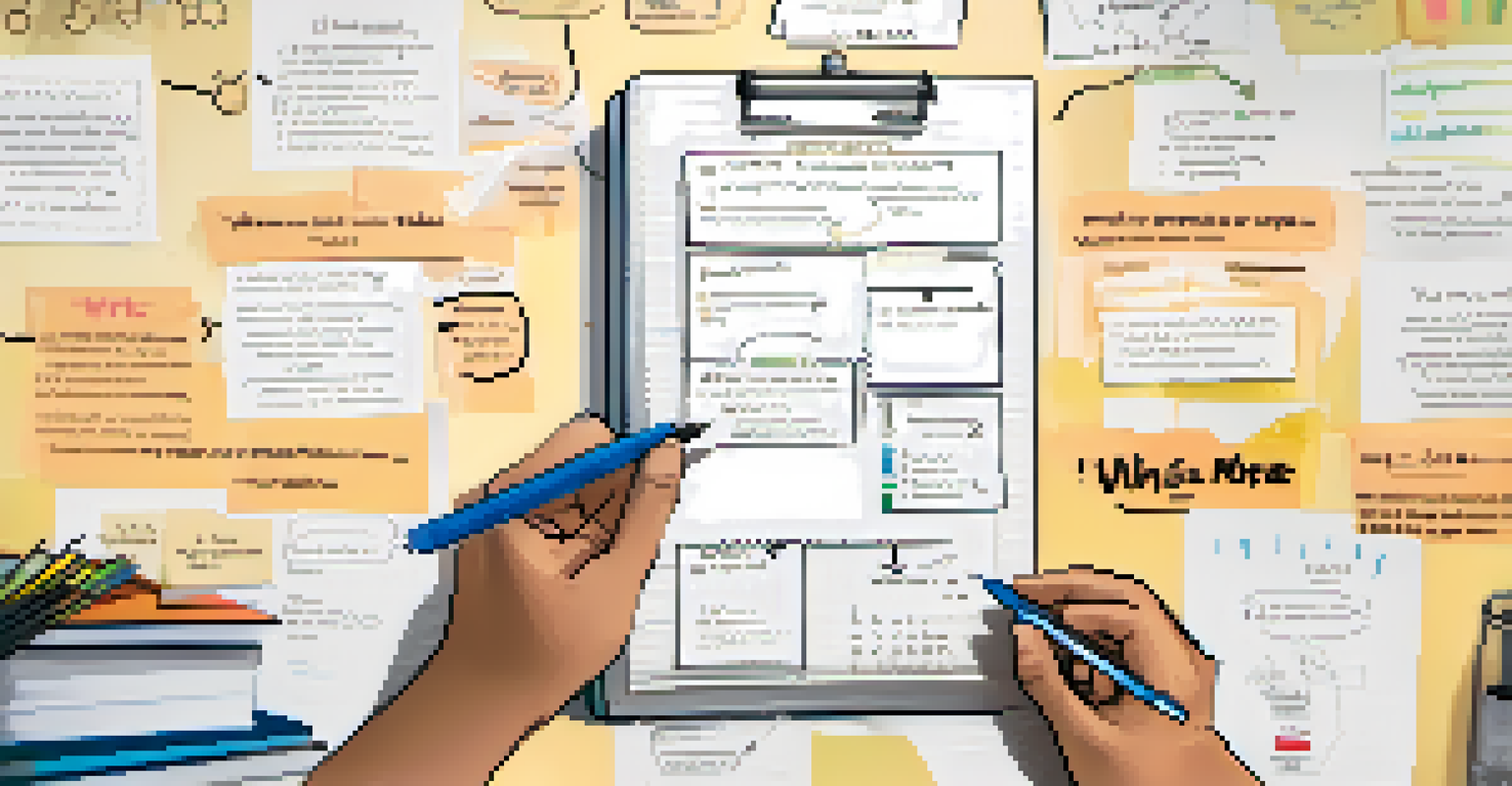Techniques to Develop Critical Thinking Skills at Work

Understanding Critical Thinking and Its Importance
Critical thinking is the ability to analyze information objectively and evaluate it based on facts. In the workplace, this skill is essential for making informed decisions, solving problems, and fostering innovation. It empowers employees to question assumptions and consider alternative perspectives, which ultimately leads to better outcomes.
Critical thinking is the key to unlocking the potential of your team and organization.
The importance of critical thinking can't be overstated; it helps teams navigate complex challenges and adapt to change. In a world where information is abundant yet often misleading, honing this skill allows professionals to discern what truly matters. This not only enhances individual performance but also contributes to the organization’s overall success.
Moreover, developing critical thinking skills fosters a culture of collaboration and open dialogue. When team members feel confident to share their thoughts and challenge ideas, it leads to richer discussions and more effective solutions. In turn, this environment encourages continuous growth and learning, which is vital in today’s fast-paced work landscape.
Encouraging Questioning and Curiosity
One of the simplest ways to promote critical thinking is by encouraging a questioning mindset. When employees feel free to ask questions, it opens the door to deeper understanding and exploration. For instance, instead of just accepting a process or procedure, team members should be encouraged to ask why it exists and if it can be improved.

Curiosity drives critical thinking and can be nurtured through various activities. Implementing brainstorming sessions or regular team discussions can stimulate this inquisitive nature. By creating a safe space for questions, you empower employees to dig deeper into issues and seek innovative solutions.
Importance of Critical Thinking
Critical thinking empowers employees to analyze information and make informed decisions, leading to better outcomes in the workplace.
Additionally, modeling curiosity as a leader sets a powerful example. When leaders demonstrate an eagerness to learn and explore new ideas, it inspires their teams to do the same. This collective curiosity fosters a culture where critical thinking is not just encouraged but celebrated.
Utilizing Real-World Scenarios for Practice
Hands-on experience can significantly enhance critical thinking skills. By utilizing real-world scenarios, employees can practice analyzing information and making decisions based on practical situations. This approach allows them to apply theoretical knowledge to tangible problems, making learning more relevant and impactful.
The ability to think critically is the foundation for effective decision-making and problem-solving.
For example, consider conducting workshops or role-playing exercises that reflect actual workplace challenges. Such activities help teams navigate complex situations together, sharpening their analytical skills in a controlled environment. This experiential learning approach not only builds confidence but also strengthens collaboration among team members.
Moreover, discussing past projects—both successes and failures—can provide valuable insights. Reflecting on what worked and what didn’t allows teams to learn from experience and develop better strategies for future challenges. This reflective practice is a key aspect of honing critical thinking skills.
Encouraging Diverse Perspectives in Team Discussions
Diversity in thought can lead to richer discussions and better problem-solving. When team members bring different backgrounds, experiences, and viewpoints to the table, it fosters a more comprehensive analysis of issues. Encouraging this diversity not only enhances critical thinking but also leads to innovative solutions.
To cultivate diverse perspectives, consider implementing practices like rotating team roles or inviting guest speakers from different fields. This exposure allows employees to see challenges from various angles, broadening their understanding and enhancing their critical thinking capabilities. It also creates an inclusive environment where everyone feels valued.
Encouraging Curiosity and Questions
Promoting a questioning mindset and curiosity among team members fosters deeper understanding and innovative problem-solving.
Additionally, actively seeking out differing opinions during discussions can spark deeper analysis. When team members are encouraged to present counterarguments, it challenges assumptions and promotes a more thorough exploration of ideas. This practice not only improves critical thinking but also strengthens team cohesion.
Implementing Structured Problem-Solving Techniques
Structured problem-solving techniques provide a clear framework for critical thinking. Methods like the '5 Whys' or SWOT analysis (assessing Strengths, Weaknesses, Opportunities, and Threats) can guide employees through a systematic approach to understanding issues. These frameworks make complex problems more manageable and encourage thoughtful analysis.
For instance, using the '5 Whys' technique involves asking 'why' repeatedly until the root cause of a problem is identified. This process helps teams dig deeper into issues rather than just addressing symptoms. By implementing structured approaches, organizations empower employees to tackle challenges with confidence and clarity.
Moreover, regular training on these techniques can reinforce their importance and effectiveness. Workshops or online courses can help employees become familiar with various problem-solving methods, equipping them with the tools needed to enhance their critical thinking skills. This investment in training ultimately leads to a more competent and agile workforce.
Fostering a Growth Mindset within Teams
A growth mindset is the belief that abilities and intelligence can be developed through dedication and hard work. Cultivating this mindset within teams encourages members to embrace challenges and view failures as opportunities for learning. This shift in perspective is crucial for enhancing critical thinking skills.
To foster a growth mindset, leaders should celebrate effort and progress rather than just outcomes. Recognizing team members for their attempts to tackle tough problems, even if they don’t succeed, promotes resilience and encourages further exploration. Over time, this environment nurtures critical thinking as employees become more willing to take risks.
Fostering a Growth Mindset
Cultivating a growth mindset encourages teams to embrace challenges and view failures as opportunities for learning and improvement.
Additionally, providing constructive feedback is essential for developing a growth mindset. Instead of simply pointing out mistakes, feedback should focus on what can be learned from the experience. This approach not only builds critical thinking skills but also strengthens relationships within the team, creating a more supportive work atmosphere.
Encouraging Continuous Learning and Development
Promoting a culture of continuous learning is vital for enhancing critical thinking skills. When employees are encouraged to seek new knowledge and skills, they become more adept at analyzing information and solving problems. This commitment to ongoing development keeps the workforce agile and open-minded.
Incorporating professional development opportunities, such as workshops, online courses, or industry conferences, can stimulate this culture. Providing resources for employees to learn new skills not only benefits them personally but also enhances the organization’s overall capability. It’s a win-win scenario that supports critical thinking at every level.

Moreover, encouraging peer learning through mentorship or knowledge-sharing sessions can further enhance critical thinking skills. When team members share insights and experiences, it leads to a richer understanding of diverse perspectives. This collaborative approach to learning fosters an environment where critical thinking flourishes.